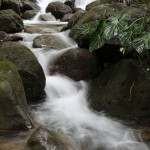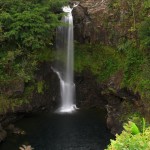The flowing stream. An easy and fun shot that should be in any photographers skill set. Not only a pretty shot that captures the feel of a flowing stream, but a shot that teaches a little basic photography in the taking.

While I was taking this shot another couple was taking the same photo beside me on the bridge. They wondered what I did to get the shot they saw on my screen. I offered them a turn on my tripod for a moment and talked them through the steps needed to create the flowing stream look. The Canon Rebel T5i they were using was perfectly capable of achieving the same effect. A minute later they had succeeded, happy with a very pretty photo. I suspect they learned a little in the process.
Learning this effect does take very little time, only a minute or two to demonstrate. There are several simple steps to getting the flowing water effect. You will need to shoot a long exposure, 1/8 second or longer. To allow this long exposure during the day a very small aperture will be used.

Set the camera for either time (Tv) or aperture (Av) priority. Selecting Av and a small aperture (f/18 or f/22) will allow less light into the camera and require the camera to select a slow shutter. If you use time priority and select a slow shutter speed (1/8″ or longer) the camera will be forced to use a small aperture to get the correct exposure. Either way will achieve the same end.
The long shutter times will require the camera to held very still. This is best achieved with a tripod that allows complete flexibility in setting up the desired scene. In a pinch you can set the camera on a railing, convenient rock, or atop the camera bag. Set the self timer to a couple seconds to eliminate the bounce of pressing the shutter button, or use a cable release.
Other tricks will allow the camera to take longer exposures in daylight. Be sure to set the gain (ISO) as low as possible, usually 80 or 100 on most cameras. Using a neutral density (ND) filter will also reduce the light entering the camera. Some models like the Canon G series feature a built in ND filter just for this reason.
The small apertures used will have another effect, high depth of field. Everything from the foreground rock to the trees in the background will be in focus.

Once you have composed the frame and are set for long shutter speeds you are ready to fire. I would recommend shooting the exposure at several different shutter speeds. Differing exposures will have differing effects on the moving water. Once you are set up it is not problem at all to experiment with a few shots, you can choose which one you like best later at the computer.
Shorter exposures (1/8 or 1/4sec) will show some detail in the water, the streaks of individual droplets. Longer exposures (1/2 or 1sec) will create a more continuous flow. Even longer, several seconds, creates a dreamy or foggy effect. The effect will also be different depending of the distance to the water, a stream right in front of the camera will appear different than a waterfall in the distance.
This same technique can be used in other situations besides flowing water to create dramatic photographs. Ocean waves become ethereal, moving traffic or throngs of people blur into action. Above all the trick can be fun, making photography more enjoyable. Have fun, be creative, and shoot.

